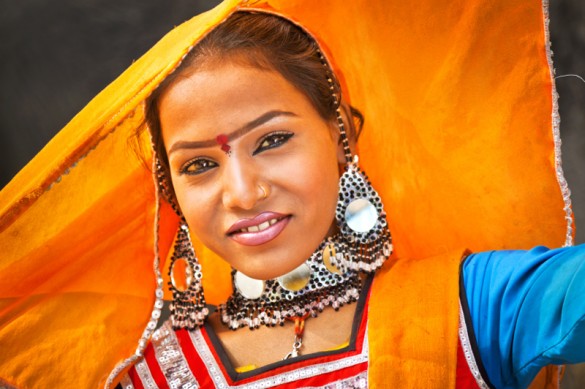Zuletzt aktualisiert: 20. November 2021
Bei derzeit 1,2 Mrd. Einwohnern wird es bis zur Mitte des Jahrhunderts voraussichtlich nicht nur das bevölkerungsreichste Land der Erde sein, sondern auch mit seinem Bruttoinlandsprodukt nach China und den USA an dritter Stelle liegen. Zu den wichtigsten Industrien des Landes gehören die Textil,- Stahl,- Maschinen- und die chemische Industrie.
Auch die Filmindustrie hat mit ihren „Bollywood“-Filmen, d.h. Liebes-Tanzfilmen, mächtig an Zuspruch gewonnen. Filmschauspieler wie Shahrukh Khan haben einen Kultstatus wie Brad Pitt oder George Clooney. Die Tourismusbranche profitiert von diesem Hype und lockt nach wie vor viele Touristen in das Land, das neben dem Taj Mahal zahlreiche Sehenswürdigkeiten bietet. Religiöse Feste sind hier sehr wichtig. So feiert in diesen Tagen das ganze Land auch wieder seinen Sonnengott.

Sprachenvielfalt:
In Indien werden so viele verschiedene Sprachen und Dialekte gesprochen wie in kaum einem anderen Land der Erde. Mehrere Hundert kleinere Sprachen aus verschiedenen Sprachfamilien verteilen sich über das Land. Die bedeutendsten von ihnen erkennt die Verfassung als offizielle Sprachen an. Auf dem Übersetzungsmarkt spricht man deshalb nicht einfach von Übersetzungen Deutsch- Indisch, Indisch- Deutsch, sondern von Hindi und anderen Dialekten. Viele Menschen sagen jedoch einfach „Indisch“, aber das ist falsch und eher eine Verwechslung mit „Hindi“, was in vielen Teilen Indiens gesprochen wird. Neben den beiden überregionalen Amtssprachen Hindi und Englisch erkennt die indische Verfassung 21 weitere Sprachen an. Zudem werden einige dieser Sprachen auch außerhalb von Indien gesprochen: Tamil z.B. in Sri Lanka, Urdu in Pakistan, Nepali in Nepal usw.
Oftmals werden Behördendolmetscher oder beeidigte Übersetzer für eine beglaubigte Übersetzung in diesen Sprachen benötigt, ob bei Gericht, bei der Ausländerbehörde oder der Polizei. Hinter jeder Sprache steckt aber eine gesonderte Problematik, man kann daher nicht alle indischen Sprachen über einen Kamm scheren. Wenn zum Beispiel die sri-lankische Sprache Tamil gedolmetscht wird, haben diese Aufträge stets eine gewisse Brisanz, denn oftmals geht es um Flüchtlingsangelegenheiten. Zwar gilt der Krieg in Sri Lanka offiziell als beendet, aber was viele, die dort Urlaub machen, nicht wissen oder nicht wissen wollen ist, dass Tamilen dort noch immer grausam unterdrückt werden und daher noch immer auf der Flucht sind.
In letzter Zeit gab es auch Versuche, den Gebrauch des Sanskrit wiederzubeleben. Sanskrit ist eine klassische, heute nicht mehr als Erst- oder Muttersprache verwendete Sprache, die in Indien einen ähnlichen Stellenwert besitzt wie das Lateinische in Europa.
Indien ist also ein Land voller Faszination, Kultur und Schönheit, aber auch voller Gegensätze und daher spannend sowohl in privater, touristischer als auch in beruflicher Hinsicht!
INDIA – Let’s Dance!
Together with Brazil, Russia and China, India is one of the so-called BRIC countries, the world’s emerging economies. According to the German Federal Foreign Office, India is still home to one of the world’s most rapidly expanding economies, despite the fact that its economic growth has slowed down to 6.5 percent (in 2011/2012 compared to 8.4 percent in 2010/2011).
India currently has a population of 1.2 billion and is likely to not only become the most populated country on earth by the middle of the century, but also to boast the world’s third-highest gross domestic product after China and the USA. Some of the most important industries in India include the textile, steel, engineering and chemical industries.
The Indian film industry and its „Bollywood“ genre of romantic dance films are also becoming increasingly popular, with film actors like Shahrukh Khan gaining a cult status like Brad Pitt or George Clooney. The tourism industry also benefits from this hype and continues to attract a large number of tourists to India, offering them an abundance of sights and attractions such as the Taj Mahal. Religious festivals are a very important part of life in India. At present, for example, the entire country is again celebrating its sun god.

Language diversity:
India is home to an extremely wide range of languages and dialects that is more diverse than in practically any other country. Several hundred smaller languages from a variety of different language families are spread throughout the nation and the most important of these are recognised as official languages by the Indian Constitution. As a result, the translation market does not simply refer to „German > Indian“ and „Indian > German“ translations, but instead specifies languages such as Hindi and other dialects. A lot of people, however, still simply refer to „Indian“, which is actually incorrect and a mix-up with „Hindi“, the language spoken in many areas of India. Alongside the two official national languages of Hindi and English, the Indian Constitution also recognises 21 further languages. Some of these additional languages are also spoken outside of India, for example Tamil in Sri Lanka, Urdu in Pakistan, Nepali in Nepal, etc.
The authorities often require the services of interpreters for these languages in situations involving court action, immigration authorities or the police. The fact that every language has its own special set of problems, however, means that it is not possible to generalise all Indian languages under one banner. Interpreting work involving the Sri Lankan language Tamil, for example, has always been rather volatile because it often concerns refugee issues. Although the war in Sri Lanka is indeed officially over, a lot of people who spend their holidays there do not know, or do not want to know, that the Tamil people are still being terribly oppressed and are therefore still trying to escape from the country.
Attempts have also recently been made to resurrect the use of Sanskrit. Sanskrit is a classical language that is now no longer used as a first or native language but actually has an importance in India similar to that of Latin in Europe.
As these examples show, India is a land full of fascination, culture and beauty, but is also home to a multitude of contrasts and is therefore enthralling on a private, tourist and professional level!

